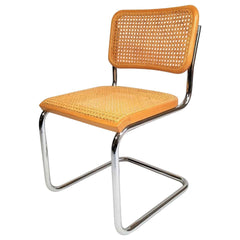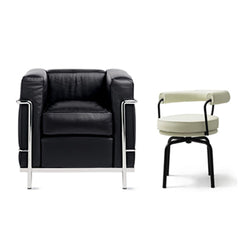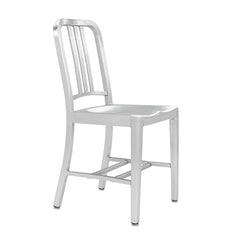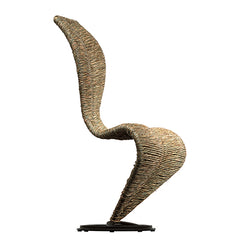
History Lesson: Chairs of the 20th Century
Share
The chair is an excellent frame with which to look at what was happening at any given time in architecture, art, and fashion. In the early 1900's the west exiting out of modernism and post-impressionism. Art was exploring concepts of representation in incredible new ways in response to the invention of the photograph.
At the same time architecture and fashion were reacting to the impact that the industrial revolution had on the manufacturing of goods. Very quickly we moved from a time of slow deliberate creation of goods to a fast and inexpensive production on a massive scale!
Unhindered access to cheap synthetic products leads the way to a new kind of furniture design. Chrome, molded plastics, wire, plywood, pressed-board became the backbone of 20th-century chair design. Thousands of new synthetic fabrics and upholstery options like microfiber, ultra suede, and vinyl emerged and gave designers an entirely new pallet to work with.
Combine these two elements and you get a perfect storm of creativity and invention!
1925-1926
The Wassily Chair was designed by Bauhas Cabinet Maker, Marcel Breuer as a conceptual piece. His goal was to embody the driving Bauhaus objective, to reconcile art and industry. It was manufactured later by Thonet a German -Austrian furniture manufacturer. It was made from plated steel and fabric held taught with springs at the back.
 1928
1928
In an attempt to reduce visual noise Marcel Breuer used a continuous line of steel supporting a cantilevered seat. These chairs employed a cantilever design that the customer seemed to defy the laws of balance and gravity, and it is still one of the most copied concepts in 20th-century furniture.
 1928 – 1930
1928 – 1930
Swiss Architect Le Corbusier revolutionized the way we think about the home and furniture. The home was a “machine for living” and the furniture inside should primarily be functional because it was in his words “equipment de l'habitation.” With this purpose, he co-designed a series of chairs with Pierre Jeanneret and Charlotte Perriand. The resulting furniture was made from tubular steel and leather.
 1940 – 1950
1940 – 1950
The Eames Side Chair was designed by Charles and Ray Eames as a submission to the “International Competition for Low-Cost Furniture Design.” Sponsored by the Museum of Modern Art, this competition was motivated by the need for low-cost post-war housing and furnishings. It is one of their most popular designs and is still popular today.
 1944
1944
First built for use on submarines in 1944, the Navy Chair is still popular even today! Craftsmen take soft, recycled aluminum, hand form and weld it- then temper it for strength. After WWII the chair became a designer chair used by many interior designers and in high-end restaurants.
 1952
1952
The Diamond Chair designed by Italian sculpture Harry Bertoia. They were made with welded steel finished in a durable nylon-dipped adhesive. Bertoia said that the chairs were “mainly made of air, like sculpture.” Having a very delicate appearance he said: “Space passes right through them.” It found immediate commercial success despite being originally made entirely by hand.
 1955-1956
1955-1956
Part of Saarinen's last furniture series, the Tulip Arm Chair resembles both a flower opening and a wine glass stem. The single-leg was used to help alleviate clutter. Saarinen said that he was interested in clarifying the structure. He said "The undercarriage of chairs and tables in a typical interior makes an ugly, confusing, unrestful world. I wanted to clear up the slum of legs. I wanted to make the chair all one thing again."
 1972
1972
Cardboard furniture started to appear in the '60s as a cheap and very light alternative to more traditional pieces. Despite best efforts using folds, tabs, slots, and more, cardboard furniture was not able to compare to the strength and durability of plastic. Canadian Architect Frand O. Gehry changed everything! He glued the cardboard sheets together to create a rigid and very stable material from which he carved intricate designs, just like he did with his models for building. The result was the Wiggle Chair, part of his larger “Easy Edges” furniture line.
 1988
1988
The Gaivota Rocking Chair, by designer Reno Bonzon was inspired by an imprint his body left in the soft snow when he was in the Alps one day. He noticed that the contours of his body and the resulting imprint were, of course, a perfect match to one another. For this reason, when you sit in the Gaivota Rocking Chair you will notice that it conforms to your shape and is incredibly comfortable even without a cushion. Bonzon's design was exceptional and he was given many prestigious awards for his work.
 1991-1992
1991-1992
The S Chair was made with a dark lacquered metal frame that was covered in woven marsh straw or wicker, or a fixed fabric or leather cover. Tunisian designer Tom Dixon was known as the “talented untrained designer with a line in welded salvage furniture" in the 1980's after he dropped out of the Chelsea School of Art to play bass in the band “Funkapolian.” He went on to create other pieces of iconic furniture for many manufacturers in the years that followed.
This list is just part of the picture. There were hundreds of incredible designs that emerged during the 20th Century, and we are still enjoying many of these designs today!
